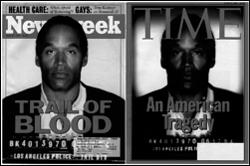They've skewered the news to avoid upsetting corporate sponsors, gotten fooled by media manipulators like Joey Skaggs, and buried anything that might embarrass the government, so what's left for the news media besides focusing on ratings? To understand how the news media works at a base level, check out the Weekly World News (www.weeklyworldnews.com), a sensationalist tabloid, as shown in Figure 15-7, which uses tactics similar to those of the more "respected" news media in order to attract an audience: Fear, Future, Fun, and Fakes.
Figure 15-7. Despite appearances to the contrary, the Weekly World News is more similar to other newspapers than you might like to think.
Whether it's the Weekly World News or the New York Times, the news media have to get people to pay attention to them, and the best way to do that is to appeal to people's fears. Fear headlines frighten but intrigue readers in much the same way that looking at a traffic accident can horrify but fascinate people at the same time. Consider these headlines from the Weekly World News:
| "Aliens using e-mail to seduce Earth women!" |
| "Real reason for war in Iraq: Bush wanted to protect the Garden of Eden from Saddam" |
| "Dolphins are growing arms and legs" ("If they learn to walk and make weapons, they would become a formidable foe for all mankind!") |
If you browse the headlines of "respected" media around the world on sites such as WorldPress.org (www.worldpress.org), World Headlines (www.worldheadlines.com), or Science Daily (www.sciencedaily.com), you can find similar fear-inducing stories, including:
| "Cheney appeals for torture exemption" (Seattle Times) |
| "Bush said God told him to invade Iraq, Afghanistan" (BBC) |
| "Scientists show how thinking can harm brain cells" (University of Rochester Medical Center) |
What makes the Weekly World News headlines funny is that we know they're fake. What makes the headlines from "respected" news media horrifying is that they're real (assuming you believe anything the news media report in the first place).
People can stand only so many threats of global warming, killer flu epidemics, or terrorist attacks, so the news media also serve up healthy doses of stories focused on an imaginary future. These headlines can take people's minds off the present, as shown in the following Weekly World News headlines:
| "Bigfoot to join the cast of 'The Sopranos'" |
| "Bill Gates to buy Mars!" |
| "Moon will hit Earth in five years!" |
The "respectable" news media also speculate about the future, but since the future changes so rapidly, predictions made today often get buried and forgotten behind newer predictions made tomorrow. The result is that the news media rarely have the time, space, or even desire to follow up on the accuracy of previous predictions, such as the following:
| "Economic 'Armageddon' predicted" (Boston Herald) |
| "Experts warn of cyber terrorist attacks" (Datamation magazine) |
| "Many in India getting ready for the coming upheaval of 2012—will we survive?" (India Daily) |
Did any of these headlines about the future come true? More importantly, did anyone even bother to check and run the follow-up story? As the Weekly World News knows, people will quickly forget past predictions as long as you keep bombarding them with new ones.
After frightening readers and distracting them with meaningless predictions about the future, the media finally needs to give people something to feel good about. Such trivia, also called human interest stories, focuses on entertaining stories and topics that appeal to the emotions, such as the following Weekly World News headlines:
| "How to tell if you've been abducted by aliens" |
| "Are demons talking to you? (Useful things you can learn from them!)" |
| "How to fool babes into thinking you're a doctor" |
In the "respectable" news media, the fun trivia stories provide a respite from the constant barrage of negative news and keep the audience from fleeing. You probably won't learn much from such trivia news stories, but then again, that might be the point, as the following headlines demonstrate:
| "Einstein Managed His Inbox Just Like You" (FOX News) |
| "Hunting Season Opens for Mythical Creature" (Associated Press) |
| "Think your house is haunted? Find out now" (CBS News) |
While everyone agrees that the Weekly World News distorts the truth and fabricates lies just to sell papers, few people want to admit that traditional news media do the exact same thing. The Weekly World News is just more upfront about it.
No one's really fooled by the poorly doctored "photographs" that appear regularly in the Weekly World News showing the president meeting with space aliens at the White House, a World War II B-17 bomber found on the moon, or a Titanic survivor peering through the closed porthole of the ship.
But plenty of people are fooled by photographs that have been subtly altered to distort reality and portray a vision that never existed in the first place, especially when those distorted images appear in "trusted" news outlets.
For its August 26, 1989, cover, TV Guide featured a picture of daytime talk-show host Oprah Winfrey. Unfortunately, it wasn't real. TV Guide later admitted that its editors had combined the head of Oprah with the body from a 1979 publicity shot of Ann-Margret. Neither Oprah nor Ann-Margret had given TV Guide permission to use their pictures. The fraud was detected by Ann-Margret's fashion designer, who recognized the gauzy dress shown in Figure 15-8.
The March 7, 2005, issue of Newsweek had a picture of a laughing Martha Stewart for its cover story about the domestic diva's imminent release from prison. However, the picture was actually a picture of Martha Stewart's head pasted on the body of a model who had been photographed in a Los Angeles studio, as shown in Figure 15-9. Newsweek did mention (in fine print) that the image wasn't real.
On June 27, 1994, Time displayed an altered version of O.J. Simpson's police mug shot, darkened to make it look more sinister. This alteration might have gone unnoticed if Newsweek hadn't used the exact same mug shot on its cover too, as shown in Figure 15-10.
In an attempt to show diversity in the student body of their school, editors at the University of Wisconsin's magazine Wisconsin digitally added a black man's face to a photograph of cheering students. The altered image appeared on the magazine's cover, as shown in Figure 15-11.
In 1997, Bobbi McCaughey gave birth to the first set of surviving septuplets. Unfortunately, Bobbi's looks were deemed not suitable for publication by Newsweek, so when the magazine put her on its cover, editors straightened and whitened her teeth. Time published a similar picture, but only whitened her teeth, as shown in Figure 15-12. Ironically, the only newspaper that showed Bobbi's teeth unaltered was the National Enquirer.






